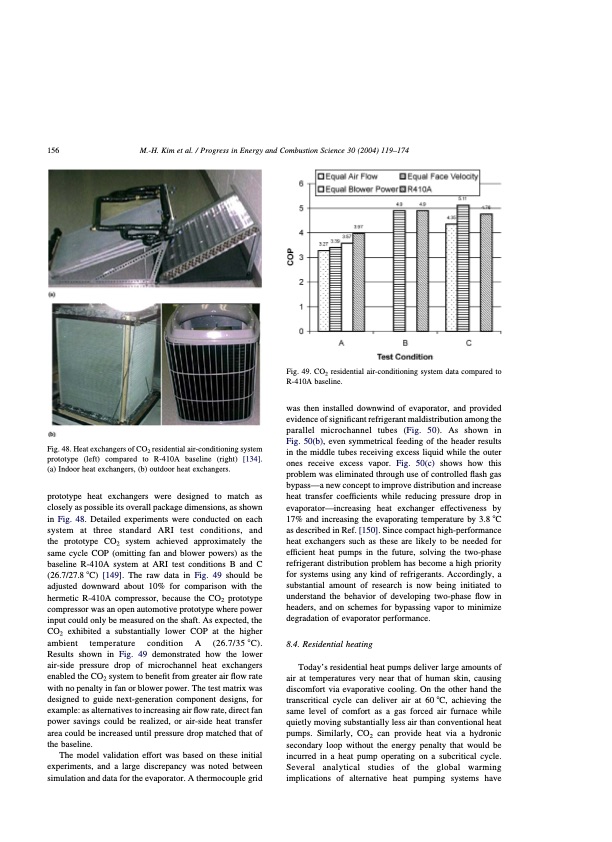
PDF Publication Title:
Text from PDF Page: 038
156 M.-H. Kim et al. / Progress in Energy and Combustion Science 30 (2004) 119–174 Fig. 48. Heat exchangers of CO2 residential air-conditioning system prototype (left) compared to R-410A baseline (right) [134]. (a) Indoor heat exchangers, (b) outdoor heat exchangers. prototype heat exchangers were designed to match as closely as possible its overall package dimensions, as shown in Fig. 48. Detailed experiments were conducted on each system at three standard ARI test conditions, and the prototype CO2 system achieved approximately the same cycle COP (omitting fan and blower powers) as the baseline R-410A system at ARI test conditions B and C (26.7/27.8 8C) [149]. The raw data in Fig. 49 should be adjusted downward about 10% for comparison with the hermetic R-410A compressor, because the CO2 prototype compressor was an open automotive prototype where power input could only be measured on the shaft. As expected, the CO2 exhibited a substantially lower COP at the higher ambient temperature condition A (26.7/35 8C). Results shown in Fig. 49 demonstrated how the lower air-side pressure drop of microchannel heat exchangers enabled the CO2 system to benefit from greater air flow rate with no penalty in fan or blower power. The test matrix was designed to guide next-generation component designs, for example: as alternatives to increasing air flow rate, direct fan power savings could be realized, or air-side heat transfer area could be increased until pressure drop matched that of the baseline. The model validation effort was based on these initial experiments, and a large discrepancy was noted between simulation and data for the evaporator. A thermocouple grid Fig. 49. CO2 residential air-conditioning system data compared to R-410A baseline. was then installed downwind of evaporator, and provided evidence of significant refrigerant maldistribution among the parallel microchannel tubes (Fig. 50). As shown in Fig. 50(b), even symmetrical feeding of the header results in the middle tubes receiving excess liquid while the outer ones receive excess vapor. Fig. 50(c) shows how this problem was eliminated through use of controlled flash gas bypass—a new concept to improve distribution and increase heat transfer coefficients while reducing pressure drop in evaporator—increasing heat exchanger effectiveness by 17% and increasing the evaporating temperature by 3.8 8C as described in Ref. [150]. Since compact high-performance heat exchangers such as these are likely to be needed for efficient heat pumps in the future, solving the two-phase refrigerant distribution problem has become a high priority for systems using any kind of refrigerants. Accordingly, a substantial amount of research is now being initiated to understand the behavior of developing two-phase flow in headers, and on schemes for bypassing vapor to minimize degradation of evaporator performance. 8.4. Residential heating Today’s residential heat pumps deliver large amounts of air at temperatures very near that of human skin, causing discomfort via evaporative cooling. On the other hand the transcritical cycle can deliver air at 60 8C, achieving the same level of comfort as a gas forced air furnace while quietly moving substantially less air than conventional heat pumps. Similarly, CO2 can provide heat via a hydronic secondary loop without the energy penalty that would be incurred in a heat pump operating on a subcritical cycle. Several analytical studies of the global warming implications of alternative heat pumping systems havePDF Image | CO2 Vapor Compression Systems

PDF Search Title:
CO2 Vapor Compression SystemsOriginal File Name Searched:
co2-vapor-compression-systems.pdfDIY PDF Search: Google It | Yahoo | Bing
CO2 Organic Rankine Cycle Experimenter Platform The supercritical CO2 phase change system is both a heat pump and organic rankine cycle which can be used for those purposes and as a supercritical extractor for advanced subcritical and supercritical extraction technology. Uses include producing nanoparticles, precious metal CO2 extraction, lithium battery recycling, and other applications... More Info
Heat Pumps CO2 ORC Heat Pump System Platform More Info
| CONTACT TEL: 608-238-6001 Email: greg@infinityturbine.com | RSS | AMP |